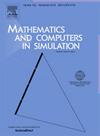An optimal and efficient framework for the construction of nonlinear components based on a polynomial ring
IF 4.4
2区 数学
Q1 COMPUTER SCIENCE, INTERDISCIPLINARY APPLICATIONS
引用次数: 0
Abstract
The widespread use of internet makes it essential to protect the private data from the intruders via developing highly secure cryptographic systems. The Substitution box (s-box) is the only nonlinear component of any security system. It plays a crucial role in securing data from an unauthorized access by inverting it into an unreadable form. The algebraic structures are mostly utilized to develop two types of s-box generators, namely the randomized and the optimal generators. The one type outputs dynamic, while the other one is responsible to design s-boxes with high cryptographic properties. However, the generator which gives highly dynamic and optimal s-boxes needs high computational overhead, which limits the encryption throughput of a large useful data set. This fact implies the need of developing an s-box generator that is capable to construct an s-box with high cryptographic properties at a low computational cost. This study presents an innovative algebraic method for constructing optimal s-boxes using a finite field and a polynomial ring. Our approach offers flexibility in selecting unconstrained primes and polynomials, allowing the generation of highly dynamic and nonlinear s-boxes. By evaluating polynomials over a finite field and introducing a new total ordering, we effectively diffuse input elements and derive optimal s-boxes with a nonlinearity of 112. We determine the total number of s-boxes based on the proposed scheme. The performance of the proposed s-box is assessed using standard metrics. We compare the attained results with that of the s-boxes constructed by the recent and state of the art algorithms. Apart from this, we compare the proposed s-box generator with an efficient one regarding the execution time and other cryptographic properties. We showed that the proposed scheme attains the highly nonlinear component approximately 5 times faster than the existing one, and the experimental results indicate that the current method outperforms than others across the standard cryptographic metrics.
基于多项式环构造非线性构件的最优高效框架
互联网的广泛使用使得通过开发高度安全的加密系统来保护私人数据免受入侵者的侵害变得至关重要。代换箱(s-box)是任何安全系统中唯一的非线性部件。它通过将数据转换为不可读的形式,在保护数据免受未经授权的访问方面起着至关重要的作用。代数结构主要用于开发两种类型的s-box生成器,即随机生成器和最优生成器。一种是动态输出,另一种负责设计具有高密码学特性的s-box。然而,生成高度动态和最优的s盒需要较高的计算开销,这限制了大量有用数据集的加密吞吐量。这一事实意味着需要开发一种能够以低计算成本构建具有高密码学特性的s-box生成器。本文提出了一种利用有限域和多项式环构造最优s盒的新颖代数方法。我们的方法在选择无约束素数和多项式方面提供了灵活性,允许生成高度动态和非线性的s-box。通过对有限域上的多项式求值并引入新的全序,我们有效地扩散了输入元素,并导出了非线性为112的最优s盒。我们根据所提出的方案确定s-box的总数。使用标准度量来评估所建议的s-box的性能。我们将获得的结果与由最新和最先进的算法构建的s盒的结果进行比较。除此之外,我们还将建议的s-box生成器与有效的s-box生成器在执行时间和其他加密属性方面进行了比较。实验结果表明,本文提出的方案比现有方案获得高度非线性分量的速度快约5倍,并且实验结果表明,当前方法在标准密码指标上优于其他方法。
本文章由计算机程序翻译,如有差异,请以英文原文为准。
求助全文
约1分钟内获得全文
求助全文
来源期刊

Mathematics and Computers in Simulation
数学-计算机:跨学科应用
CiteScore
8.90
自引率
4.30%
发文量
335
审稿时长
54 days
期刊介绍:
The aim of the journal is to provide an international forum for the dissemination of up-to-date information in the fields of the mathematics and computers, in particular (but not exclusively) as they apply to the dynamics of systems, their simulation and scientific computation in general. Published material ranges from short, concise research papers to more general tutorial articles.
Mathematics and Computers in Simulation, published monthly, is the official organ of IMACS, the International Association for Mathematics and Computers in Simulation (Formerly AICA). This Association, founded in 1955 and legally incorporated in 1956 is a member of FIACC (the Five International Associations Coordinating Committee), together with IFIP, IFAV, IFORS and IMEKO.
Topics covered by the journal include mathematical tools in:
•The foundations of systems modelling
•Numerical analysis and the development of algorithms for simulation
They also include considerations about computer hardware for simulation and about special software and compilers.
The journal also publishes articles concerned with specific applications of modelling and simulation in science and engineering, with relevant applied mathematics, the general philosophy of systems simulation, and their impact on disciplinary and interdisciplinary research.
The journal includes a Book Review section -- and a "News on IMACS" section that contains a Calendar of future Conferences/Events and other information about the Association.
 求助内容:
求助内容: 应助结果提醒方式:
应助结果提醒方式:


